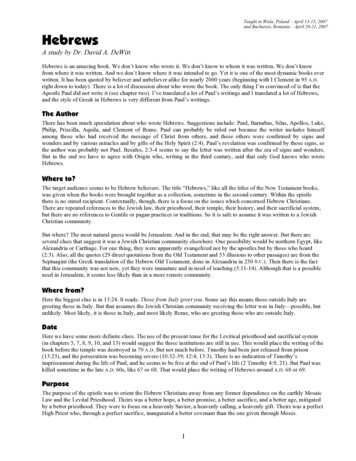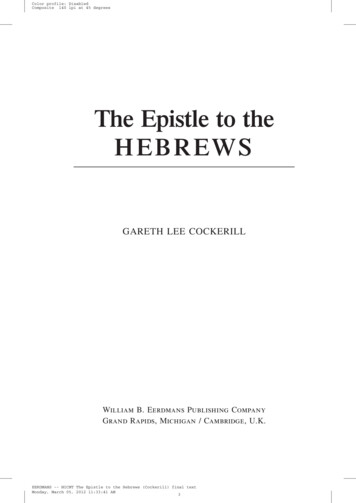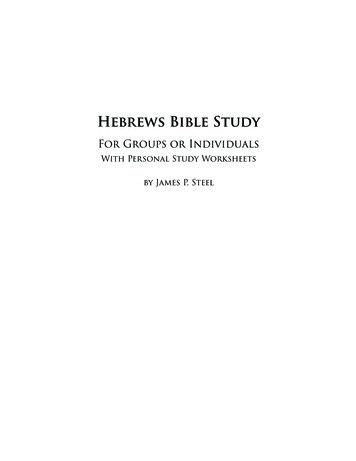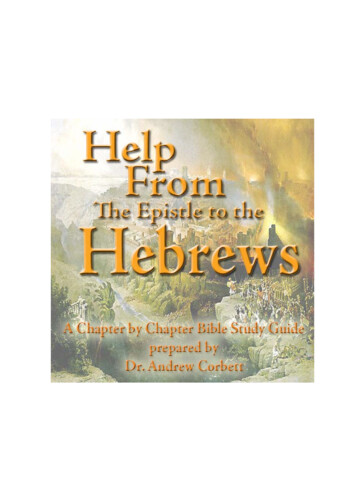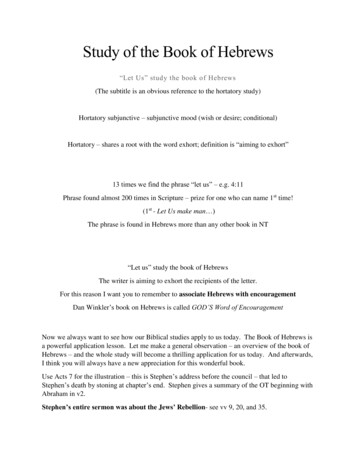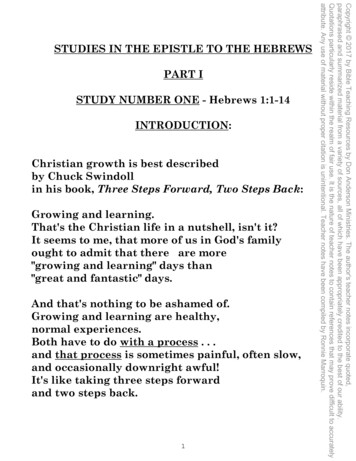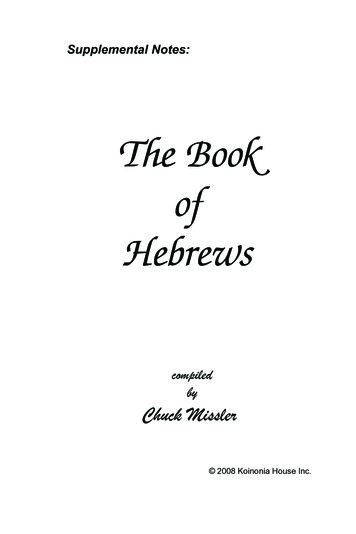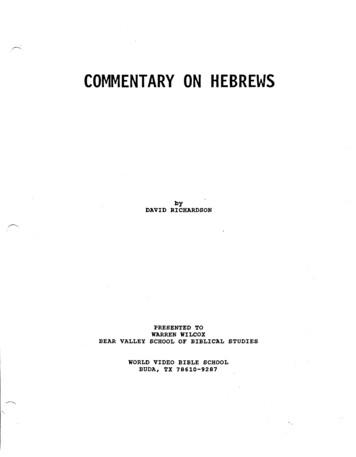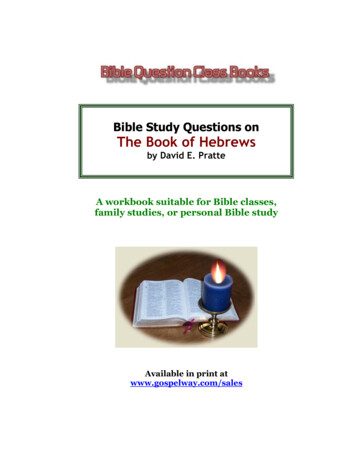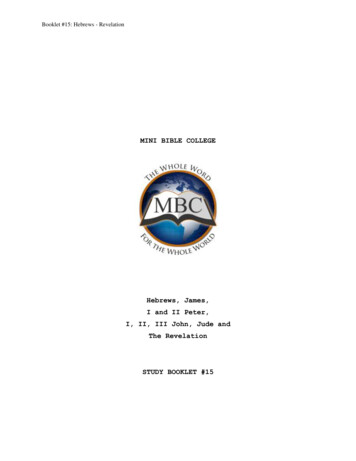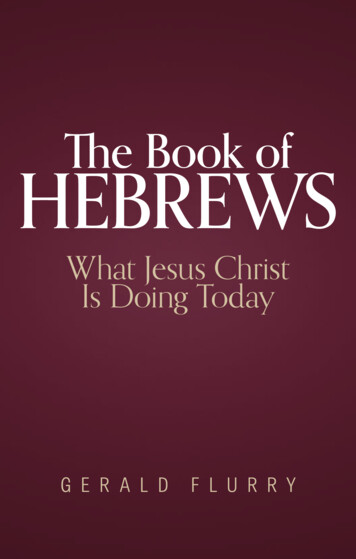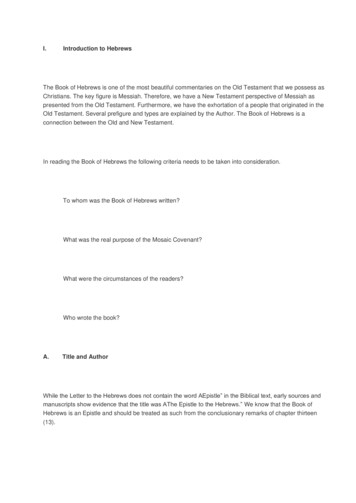
Transcription
I.Introduction to HebrewsThe Book of Hebrews is one of the most beautiful commentaries on the Old Testament that we possess asChristians. The key figure is Messiah. Therefore, we have a New Testament perspective of Messiah aspresented from the Old Testament. Furthermore, we have the exhortation of a people that originated in theOld Testament. Several prefigure and types are explained by the Author. The Book of Hebrews is aconnection between the Old and New Testament.In reading the Book of Hebrews the following criteria needs to be taken into consideration.To whom was the Book of Hebrews written?What was the real purpose of the Mosaic Covenant?What were the circumstances of the readers?Who wrote the book?A.Title and AuthorWhile the Letter to the Hebrews does not contain the word AEpistle” in the Biblical text, early sources andmanuscripts show evidence that the title was AThe Epistle to the Hebrews.” We know that the Book ofHebrews is an Epistle and should be treated as such from the conclusionary remarks of chapter thirteen(13).
2In ancient times, authorship was important. It may have meant whether or not a letter did or did not getread; much as it today. The authorship of such a letter as the Book of Hebrews could have meant that thebook did or did not get accepted as canon.Who wrote the Book of Hebrews? Scholars, both ancient and modern, are undecided on who wrote theBook of Hebrews. The following is a compendium of views on the possible author.1.BarnabasSome ancient manuscripts suggest that Paul was the author, while others suggest that Timothy wrote orproduced the book written by Barnabas. Those who suggest that Barnabas wrote the book believe that thebook was written to contend the Marcion heresy and addressed to the Laodicians or possibly theAlexandrians. Tertullian, also a Church father, suggested that the possible author was Barnabas. Barnabaswas a Levite according to the Book of Acts (4:36). This would have explained the writer’s in-depthknowledge of the Priestly office. However, such knowledge was readily available to every Jew of the FirstCentury. Scholarship has observed that the Epistle of Barnabas and the Epistle to the Hebrews circulatedtogether until about the fourth century. Though the Epistle of Barnabas was not actually written byBarnabas, it was similar in content and style to the Hebrew Epistle. Nonetheless, there is enough diversitybetween the two (2) documents to cause a reasonable doubt.2.PaulPart of the reason that scholarship contends Paul’s authorship is due to the missing prologue that isconsistent in Paul’s writings. Other scholars reject Pauline authorship based upon style and technique.There are those who have noted that certain passages within the Book of Hebrews negate Paulineauthorship. One such passage is found in chapter two (2) verse three (3). Here the author does not make aspecific reference to personally having been one of the Apostles who received the Gospel first hand. Inciting this text and argument, we must remember that Paul did receive direct revelation and communicationdirectly from the Lord.However, some aspects of the language, style, and theology of Hebrews are very similar to Paul’s epistlesand the author refers to Timothy (He 13:23). However, there are significant differences which have led
3many Biblical scholars to reject Paul’s authorship of this book. Paul was knowledgeable enough of the Oldand New Testaments to have written this book, but the actual author of the book is unknown.Many scholars accept Pauline authorship based upon the testimony of the Church Fathers such asEusebius and Clement of Alexandria. However, they are not wholly agreed. Some scholars believe thatPeter makes a reference to Paul having written a letter to the Hebrews (2Pe 3:15). The point is oftenstrengthened by the fact that the writer was in Italy, in bonds (10:34; 13:24). Further evidence is thatTimothy was a companion (13:23). In about the year 200 C.E. (Common Era) a manuscript of Paul’swriting existed on papyrus. The Book of Hebrews was included in this manuscript. Late scholarshipcontends that Paul wrote the Epistle in the terminology of the Mishnah, which was the language of therabbinic schools of the early Talmudic period.Other suggested authors are James, the brother of Jesus and author of the book titled after him. Apollos isalso suggested. He is suggested by Martin Luther. However, most contemporary scholars believe thatMartin Luther’s suggestion of Apollos is ill founded and without sufficient evidence. There are several othernames that are suggested such as: Luke, Silas, and Philip.Recent scholarship has suggested that the possible author was Priscilla, who, with her husband, gaveinstruction to Apollos. However, scholarship has noted the masculine use of terminology within the Letter tothe Hebrews.3.Comment from Early Church FathersWhen Pauline authorship was accepted in the East, it became necessary to explain why Paul’s name wasnot appended to the actual text of Hebrews. Theodore of Mopsuestia and Severian of Gabala represent thereceived interpretation that, because Paul was an “Apostle to the Gentiles,” out of tact and appropriatedeference to apostles called to the ministry to the historic people of Israel, Paul’s authorship is not explicitlymentioned in the Epistle to the “Hebrews.”a.Theodore of Mopsuestia: (c. 350–428. Bishop of Mopsuestia, founder of theAntiochene, or literalistic, school of exegesis.)
4“Paul did not write as to unbelievers who had acquired an implacable hatred against him but to believerswho have shared all things that it is necessary to share. He writes not to those who are simple in their faithbut to those who are demonstrating in their works the solidity of their faith and the keenness of their virtue,as the contents of the epistle show. Consequently, the epistle must have been delivered to them as one ofPaul’s epistles, for if this were not the case the things written would not benefit them.”“Again, in addition to these considerations the things written at the end of the epistle prove what I amstating: ‘I appeal to you, brethren’ he says, ‘bear with my word of exhortation, for I have written to youbriefly.’ But to whom did he write, ‘I appeal to you’ if those things were not the reason the letter was sent tothem? Then he adds, ‘You should understand that our brother Timothy has been released with whom Ishall see you if he comes soon.’ Clearly you see that Timothy was the one who has delivered the epistlePaul wrote, with whom Paul clearly promises also to see them, if Timothy returns.”“What then is the reason for Paul not appending his name? It is evident and very clear. Both Barnabas andPaul divided the preaching task with the disciples of the blessed Peter. [This was] not so that the formercould teach some doctrines and the latter others—for there is one goal—but so that Paul and Barnabasmight lead to faith some from the Gentiles while Peter and his disciples would lead some from the Jews tofaith, deeming this division more expedient because at that time there was still a powerful rivalry due to thecustom of the Jews (based on their law) who did not permit themselves to consort with Gentiles. Thensome of the apostles had dealings with the Gentiles, while others with the circumcised. But those who hadcome to faith in all probability deemed the teachers and apostles to be shared by both communities. Thus,when Paul wrote to the Gentiles, he in all likelihood commands them as their apostle, but when he writes tothe Hebrews, he does not. “b.Severian of Gabala: (c. 400. A contemporary of John Chrysostom, he was ahighly regarded preacher in Constantinople, particularly at the imperial court.)“The heretics say that this epistle is not Paul’s, and they offer as their first proof of this that his name is notsuperscripted as in the other epistles. Second, his vocabulary is different, that is, it is foreign to Paul’scustomary word choice and usage. One must know, however, that Paul was hated by the Jews on thegrounds that he was teaching apostasy from the law, and having been endangered for this reason inJerusalem and having scarcely escaped, he was sent to Rome. Therefore, writing something useful to theHebrews, he does not append his name, so that they might not lose any advantage they could havederived from the letter because of their hatred against him.
5And he writes to them in the tongue of the Hebrews, which was also translated by one of his disciples—byLuke or more likely by Clement who also is mentioned. For this reason the vocabulary is different. And thishas been investigated by previous generations, and Eusebius of Pamphilus, a historian of those things inpreceding and contemporary generations, made mention of the investigation, and it still seemed to ourfathers, the predecessors of the bishops, that the epistle was Paul’s.4.ConclusionThe plain simple truth is that the author remains anonymous and it is impossible to ascertain the trueidentity of the author at this late date. What we can ascertain at this point is that the readers of the Letterwere acquainted with the author and accepted the letter’s authenticity. Likewise, the author must have heldsome position of authority. His letter, thought, and exhortation carried weight with its readers. He is familiarwith their circumstances and encourages them on to maturity.The author is knowledgeable of more than just the written scriptures. He is thoroughly aquatinted with theOral Traditions, as they would be codified in the Mishnah. These traditions are a part of the author’sargument even though they are concealed to the average reader’s eye. He is aware of the traditions andinterpretations of the Biblical text in accordance with the hermeneutics of the First Century. Furthermore,he is thoroughly acquainted with the functions of the Priesthood.While the authorship of the book is contested, we now have it as a part of Christian canon, thereby makingGod the author. The message was given by the inspiration of Holy Spirit. Uncertainty plagues, not only theidentity of its writer, but also where it was written. The question of authorship delayed its recognition, in thewest, as a part of the New Testament canon in spite of early support by Clement of Rome.Not until the fourth century was Hebrews accepted as authoritative in the Western Church, when thetestimonies of Jerome and Augustine settled the issue. In the Eastern Church, there was no problem ofacceptance because Hebrews was regarded as one of the "fourteen" Epistles of Paul. The issue ofacceptance was again raised during the Reformation; but the spiritual depth and quality of Hebrews borewitness to its inspiration, despite the questions about the author.B.Audience
6James, Peter, John, Jude, and Paul are the most notable letter writers of the New Testament. Some of theauthors wrote to the Messianic Jews of their day. Paul addressed Gentiles in several of his letters. Withouta doubt, this letter was written specifically to Messianic Jews. However, many scholars are beginning tobelieve that many of the letters of James, Peter, John, and Jude were also sent specifically to MessianicJews. We can readily determine the letter written by the hand of James was sent to Messianic Jews by itsprologue.Undoubtedly the Book of Hebrews was written to a group of Jewish Believers. They had come to faith inJesus as the Messiah. The letter is most assuredly addressed to a specific group or congregation of Jewsand not just Jews in general. It has been argued by some scholars that the intended audience was theEbonites. The Ebonites were Messianic Jews who were possibly the extreme legalists of the Book of Acts.As a matter of fact, some scholars suggest that the Book of Hebrews is a continuation of the thoughts ofthe Book of Acts.Their approach was legalism as a method of Salvation rather than faith. They were “zealous of the Law,”(Ac.21:20). Their demand in Acts 15 was that the Gentiles be circumcised and keep the Law as a meansof Salvation. As Jews who believed in the Messiah, they could acknowledge no other answer to thequestion of Gentile Salvation. How could the Gentiles become a part of the “People of God”? Their viewwas through acceptance of the Jewish Covenant of Election by means of circumcision. This was the basicformat for conversion to Judaism in ancient times. They saw it as the means for Salvation, period. Jew andGentile alike must be circumcised and keep the Torah. All sources seem to indicate that they werePharisee converts to Christianity from the Rabbinic School of Shammai.Many scholars believe that the audience was Jewish Believers, having accepted Jesus as the Messiah;they wanted to reverse their course in order to escape persecution by some of their own countrymen andGentile oppression. The writer of Hebrews exhorts them to "press on to maturity” (6:1). Thisencouragement is based on the excellence of Messiah and His work. Messiah is better than the angels,for the angels worship Him. Christ is better than Moses, Christ created him. Christ is better than theAaronic Priesthood, for Christ’s sacrifice was once and for all time. He is the goal of the Law and Hemediates a preferable covenant (Ro 10:4). In short, there is more to be gained in Messiah than to be lostin Judaic legalism.This epistle deals specifically with the relationship of the Old Testament and the New Testament revelationand is the unifier of both.
7Many places have been suggested for the location of the readers, but the destination of this letter cannotbe determined with any certainty. The recipients of this letter were Believers (3:1) who had come to faiththrough the testimony of eyewitnesses of Christ (2:3). They were not novices or mature (5:12), and theyhad successfully endured hardships because of their stand for the Gospel (10:32-34). Unfortunately, theyhad become "dull of hearing" (5:11) and were in danger of drifting away (2:1, 3:12). This made themsensitive to the renewed persecutions that was coming upon them (12:4-12), and the author found itnecessary to check their downward spiral with "this word of exhortation" (13:22). While there isdisagreement over the specific danger involved, the classic position is that the readers were on the vergeof lapsing into Judaism to avoid persecution directed at Jewish Christians. The Book of Hebrews repeatedemphasis is on the superiority of Messiah.C.DateIt is difficult to ascertain the date of origin due to the lack of information concerning the authorship. Theplace of the writing is unknown, but a date can be approximated. Hebrews was quoted in A.D. 95 byClement of Rome. The author speaks of the sacrificial system in the present tense indicating that they werestill being practiced in the Temple. As a result of the present tense of the Temple cult which ended withdestruction of the Temple in A.D. 70 indicates that it was prior to that date. However, some scholarshipconsiders this information inconclusive since the Mishnah, compiled after the destruction of the Temple,also speaks of the sacrificial system in the present tense.Timothy was still alive (13:23), persecution was mounting, and some time had passed since the death andresurrection of Christ. However, some scholars suggest that Timothy died in 94 A.D. Those who areaddressed in the Epistle were not new to the Messianic Faith. All of this suggests a date between A.D. 64and 68. If the author was Paul, the letter could not have been written any later. However, based upon thethesis that the terminology of the Mishnah was used in the Epistle, recent scholarship postpones that dateto after A.D. 70. The reasoning behind the late date of authorship is because of the difficulties thatpresented themselves to both the Messianic and Jewish Communities in the wake of the Temple’sdestruction. The great question was what to do in the absence of the sacrificial system. The RabbinicCommunity resolved its problems with fasting, almsgiving, study and prayer. However, the MessianicCommunity turned its faith to Messiah who was the once and for all sacrifice needed to procure Salvationfor those who put their faith in Him. Therefore, the questions that presented themselves to bothcommunities are answered in the Letter to The Hebrews.Another highly debated issue that undoubtedly brought division between the Messianic Believers and theJews of the Synagogues was the destruction of the Temple. Even though Jesus prophesied its destruction,
8the Jews looked for a Messianic figure that would overthrow Rome and establish, once and for all, theKingdom of Israel. Herein was the misconception as to what the Kingdom of God really was. The Jewsbelieved that the Kingdom of God and the Kingdom of Israel was in fact the same thing. However, the Bookof Acts negates this idea. Jesus was not concerned with the Kingdom of Israel at His resurrection. He,throughout His ministry, repeatedly preached the Presence of the Kingdom of God.Furthermore, all the references to the Temple are not in fact references to the Temple. Rather, allreferences to the sacrificial cult of Israel are references to the Tabernacle or Tent of Meeting. This wouldmake the Letter readable to the Essene or Qumran Communities, as well as, the other JewishCommunities of the period. However, it could also hold reference to post-Temple time, because theTemple had already been destroyed.James the Righteous, brother of Jesus, was the apparent leader of the Messianic Community (Acts 15). Asthe leader of the Messianic Community, he offered encouragement and perseverance to his constituents.Some scholars have suggested that with his death and the mounting persecution that the MessianicCongregations would have considered themselves oppressed and persecuted. As a result, the MessianicCommunity to whom the Letter of Hebrews was addressed would have needed encouragement tocontinue. For them, it would have been much easier to defect than to proceed. However, defection is neverthe answer to persecution and oppression.Another thing that discouraged the Messianic Community was the return of the Lord. Why had Hepostponed His coming? It is much like how the believing community must feel today. They neededencouragement to continue.Therefore, the date of the writing is placed somewhere between A.D. 60 and 95.D.LanguageWhile many New Testament scholars struggle with the language of the New Testament, the NewTestament itself bears witness to extensive use of the Hebrew tongue. Clement of Alexandria suggestedthat Paul wrote the letter and that he wrote it in Hebrew. Origen, one of the Church Fathers, testified thatthe original writing was in Hebrew and that Luke painstakingly translated it into Greek. For us to have
9translations and manuscripts in Greek is a natural course of events. With the Gentile acceptance of theGospel, there was a great need for a Greek translation of Scriptures. This was equally true of the Epistles.However, the most ancient transcripts are Greek, and to date, there is no physical evidence of a Hebreworiginal.Of all the Books of the Bible that focus our attention on the person and work of Jesus Christ revealing Himto be the key to the Scriptures, this epistle is undoubtedly the greatest and most important.E.PurposeThe genre of Hebrews is unusual. The book is without an introduction or other early indications that it is aletter. Yet the final verses do pass on greetings and blessings (13:23–25), and the author speaks of having“written to you” (13:22). However, the author also identifies his work as a “word of exhortation” (13:22). Thecareful rhetorical progression of the Book, along with its frequent practical exhortations, has led many toconsider it a single sermon. Perhaps Hebrews is best understood as a sermonic letter. Hebrews frequentlyencourages the audience to endure and warns against leaving Christ (2:1-4; 3:7-4:13; 5:11-6:12; 10:19-39;12:1-29). These warning passages are interspersed throughout the Book and have noticeable structuralsimilarities (esp. in terms of exhortation and threatened consequence). Around these passages theargument of the Book progresses carefully. Moreover, these specific exhortations themselves flow out ofthe surrounding material. Thus the Book is unified in both structure and intent.The warning passages exhort church participants to remain faithful. The more expository sections of theEpistle show the superiority of Christ and His New Covenant work to angels, Moses, the tabernaclepriesthood, and the sacrificial system. The implication is that these are so inferior to Christ that it is futile toreturn to them (or to go anywhere else). Thus the Book encourages the Church to hold fast to its faith,because that faith is grounded in the most superior revelation.The background of such exhortations must have been the audience’s need to continue enduring throughpersecution and the trials of life (e.g., ch. 12). They appear to have grown less attentive to Christianinstruction (5:11-14); and some apparently have ceased regular attendance at their meetings (10:25).Nonetheless, the author reminds them of their past faithfulness and communal love in the midst ofpersecution (10:32-34). He encourages their faithfulness by careful exposition of the Old Testament, inlight of the revelation in Jesus Christ.
10In addition, there are two (2) basic schools of thought about why the Book of Hebrews was written.1.For those being persecuted and about to defect.This view is undoubtedly one of the most commonly held views with Christianity. The general consensus isthat the Jewish Community of Believers was being persecuted from without and within. This persecutionwas so great that there were those who wanted to defect from the Messianic faith. Given the early historyof the Church, this is highly possible. In this view, those who were facing persecution were caughtbetween two (2) struggling factions. They faced the possibility of physical death. Again, this was verypossible. Many Jewish-Christians lost their lives during the early Church period.Some have suggested that the audience of Hebrews only wanted to temporally go back until thepersecution subsided. The Book of Hebrews gives little or no evidence to this view.Difficulties with this view include: 1) While the Author argues a variety of things, he never argues theMessiah-ship of Jesus. He naturally assumes it; 2) He does not reprimand his readers for engaging inJewish rituals and practices.2.The Jewish-GalatiansPaul’s letter to the Galatians, a Gentile Church, was written because there were those Jews that insistedthat Proselytization was an essential part of Salvation. The writer of Hebrews makes very much the sameargument. However, here the audience is strictly Jewish. So, rather than accept this error thatProselytization and acceptance of Messiah’s sacrifice guaranteed Salvation, the author rejected it. Heargues that the rituals are but a shadow of the real truth, which is Messiah. Therefore, it was necessary tolook beyond the mundane. Those who held this world view placed Messiah second to proselytization. Thisproselytization involved a ritual acceptance of the Torah from a legalistic approach as a means toSalvation. It required ritual circumcision and washing, baptism as a visible sign of the rebirth of theproselyte. This was the reason for the great council in the Book of Acts chapter fifteen (15) and the writingof Paul’s letter to the Galatians. As a matter of fact, this is the basis for many of Paul’s writings. He did notargue the validity of the system God established through Moses. He argues against legalism as debated bya select few. As a result, the Author argues the superiority of Messiah and the Messianic Way.
113.The Two (2) natural divisions of HebrewsThe Book of Hebrews, like Paul’s writings, falls into two (2) different natural categories. The first section ofthe book is doctrinal. Hebrews chapter 1-10 are primarily doctrinal in content. Chapters 11-13 are practical.They teach those who are exhorted in the primary chapters through doctrine how to apply the doctrines theAuthor has presented.Regardless of the potential audience, the Author tells those in Christ how they should act. He goes furtherto teach them the relevancy of Faith.” Faith must be relevant in order to be of value. Religion withoutrelevance is of no value and just religion.” Faith must be active and vital to be of any consequence. Theaudience was losing its faith and hope in Jesus, as the Messiah. This was most likely because of thecircumstances that were prevalent in their day. These Jews were about to return to their old ways. Whilethere are those who would look upon them with disdain, we must realize that when things get toughregardless of your previous belief, many return to their old practices. It does not have to be a legal system;it could be just sin,F.The Messiah of HebrewsWithin the Book of Hebrews three (3) mysteries are revealed.1.The opening of the Heavenly Sanctuary2.The Sacrifice of Messiah as the way to God3.Jesus as our High Priest
12Messiah is our eternal High Priest according to the order of Melchizedek. He identified with man in Hisincarnation and offered no less a sacrifice than Himself on our behalf.Hebrews presents Messiah as the Divine-human Prophet, Priest, and King. His Deity (1:1-3,8) andhumanity (2:9, 14, 17, and 18) are asserted with equal force, and over twenty titles are used to describeHis attributes and accomplishments. Titles such as, "Heir of all things", Apostle, High Priest, Mediator,Author and Perfecter of faith can be found. He is superior to all who went before and offers the supremesacrifice, Priesthood, and covenant.G.Keys to HebrewsKey words: The excellence of MessiahThe basic theme of Hebrews is found in the word "better", describing the excellence of Messiah in Hisperson and work (1:7; 6:9; 7:19, 22; 8:6; 9:23; 10:34; 11:16, 35, 40; 12:24). Better” here does not imply amoral idea but rather a place of rank. The words perfect (perfection, perfected), eternal (everlasting,forever, evermore), heavenly (heaven, heavens), and partakers are also used extensively. He offers abetter revelation, position, priesthood, covenant, sacrifice, and power. This epistle is also written to exhortits audience to become mature in Christ and to put away spiritual dullness. The Book of Hebrews places aheavy stress on Messiah and maturity. Christ is greater than any angel, priest, or old covenant institution;thus each reader, rather than leaving such a great salvation, is summoned to hold on by faith to the truerest found in Christ and to encourage others in the Church to persevere.Following is an expanded Key Theme summary:a.Jesus is fully God and fully man (1:1-14; 2:5-18).b.Jesus as Son of God reveals God the Father, is the agent of creation,and sustains all creation (1:1-14).
13c.Jesus serves as the eternal high priest, who as a man sympathizeswith human weaknesses, and yet who offered himself as the perfectsacrifice for sin (1:3; 2:10-18; 4:15-16; 9:11-10:19).d.Jesus is superior to angels, to Moses and the Mosaiccovenant, and to the earthly tabernacle and its priesthood (1:4-2:18;3:1-6; 5:1-10; 7:1-10:18; 8:1-13).e.All humanity faces eternal judgment for sin (4:12-13; 9:27-28; 10:2631).f.Faith is necessary to please God and to participate in His eternalsalvation promises. Faith requires conviction about the unseenrealities of God and His promises. Such faith produces perseverance(4:2-3; 6:1, 12; 10:22, 38-39; 11:1-40).g.Perseverance is necessary in the Christian life, and thus churchparticipants are warned against a lack of endurance (2:1-4; 3:7-4:13;5:11-6:12; 10:19-39; 12:1-29).
14h.God’s promises are trustworthy, including His promise of eternalsalvation (6:13-20).i.With the advent of Jesus Christ, the last days have begun, thoughthey await consummation at His return (1:2; 2:5; 4:9-11; 9:9-28;12:22-29).The key verses of Hebrews are 4:14-16 and 12:1-2. The key chapter is Hebrews 11. In chapter 11, we findthe “Hall of Faith” which records those who willingly took God at His Word even when there was nothing tocling to but His promise. Common to all those listed is the recognition that they pleased God (He.11:6).H.Short Survey of HebrewsHebrews stands alone among the New Testament Epistles in its style and approach. It is the only NewTestament Book whose authorship is in question. The book builds a case for the excellence of Messiah, inwhich Messiah is presented as "better" in every respect. Again, “better” here does not imply a moral ideabut rather a place of rank. God is truly superior to His Word being its Author. In His person, He is higher inposition than the angels, Moses, and Joshua; and in His performance, He provides a superior Priesthood,covenant, sanctuary and sacrifice. Evidently, the readers are in danger of defection because of thesuffering they are beginning to experience for their faith in Messiah, or they are being persuaded thatsimple faith in Messiah is not sufficient as a means of Salvation. Not only is the Preeminence of Christpresented, but the writer of Hebrews gives five solemn warnings (2:1-4; 3:7 - 4:13; 5:11- 6:20; 10:19-39;12:25-29). These warnings include cautions against neglect (2:1-4) and refusal (12:25-29). After usingScripture to demonstrate the excellence of Messiah’s person (1:1 - 4:13) and the excellence of Messiah’swork (4:14 - 10:18), the writer applies these truths in a practical way to show the superiority of theMessianic walk of faith (10:19 - 13:25).1.Loftiness of Messiah’s person: 1:1- 4:13
15Instead of the usual prologue, Hebrews launches directly into its subject. That subject is the Pre-eminenceof Messiah over even the Prophets (1:1-3). Christianity is built upon the highest form of Divine revelation.This revelation is the revelation of Messiah, which was previously held in mystery. Christ is therefore, thesenior of the prophets, sovereign over the angels, and He is the mediator of t
Hebrews is an Epistle and should be treated as such from the conclusionary remarks of chapter thirteen (13). 2 In ancient times, authorship was important. It may have meant whether or not a letter did or did not get read; much as it today. The authorship of such a letter as the B
